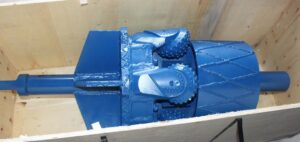Introduction
Friction is a significant challenge in drilling operations. It affects the efficiency and lifespan of PDC (Polycrystalline Diamond Compact) bits. Reducing friction can lead to faster drilling, lower energy consumption, and extended bit life. This article explores various friction reduction techniques used in PDC bits, including coatings, micro-structured surfaces, and lubrication strategies.
Importance of Reducing Friction
High friction levels during drilling can lead to excessive wear and overheating. When friction increases, so does the energy required to drill. This leads to higher operational costs and shorter bit lifespans. Reducing friction helps in maintaining optimal drilling parameters, which enhances performance. A lower coefficient of friction means better energy efficiency, translating into cost savings for operators.
Coating Technologies
One effective method for reducing friction in PDC bits is through advanced coatings. These coatings can be made from various materials, such as diamond-like carbon (DLC) or tungsten disulfide (WS2). DLC coatings provide a hard, smooth surface that minimizes friction. WS2 is known for its excellent lubricating properties and can withstand high temperatures. Applying these coatings to the bit’s cutting edges reduces wear and enhances drilling performance.
Micro-Structured Surfaces
Another innovative approach to reduce friction is through micro-structured surfaces. These surfaces are designed with tiny grooves or textures that disrupt the contact area between the bit and the rock. By creating a non-uniform surface, the effective contact area is reduced, which in turn decreases friction. This technique not only lowers wear rates but also improves the bit’s ability to remove cuttings from the hole, enhancing overall drilling efficiency.
Lubrication Strategies
Proper lubrication is crucial in minimizing friction during drilling. Various lubrication strategies can be employed, such as the use of drilling fluids or specialized lubricants. These fluids can reduce friction at the bit-rock interface and help dissipate heat generated during drilling. Additionally, using environmentally friendly lubricants can also enhance performance while adhering to safety regulations. Effective lubrication not only lowers friction but also helps in extending the operational life of the PDC bits.
Challenges and Future Directions
While friction reduction techniques have shown significant benefits, challenges remain. The effectiveness of coatings may diminish over time due to wear. Similarly, maintaining micro-structured surfaces can be difficult in harsh drilling environments. Future research may focus on developing more durable materials and innovative lubrication solutions. Combining multiple friction reduction techniques may also lead to even greater efficiencies and performance improvements.
Conclusion
Friction reduction is critical for enhancing the performance of PDC bits. Techniques such as advanced coatings, micro-structured surfaces, and effective lubrication play key roles in minimizing wear and improving drilling efficiency. As the industry evolves, continued innovation in these areas will be essential. By focusing on reducing friction, operators can achieve significant cost savings and improve overall drilling operations.


